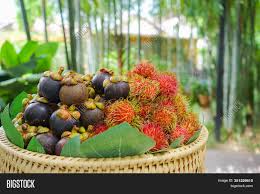The Origins of a Remarkable Fruit
In the lush, tropical landscapes of Southeast Asia, where the air hums with life and the soil is rich with possibilities, the rambutan (Nephelium lappaceum) tells a story of resilience, adaptability, and the sweet rewards of perseverance. Its history is deeply entwined with the cultures and kingdoms of the Malay Archipelago, where it was first cultivated and celebrated centuries ago.
The story of rambutan dates back to as early as the 13th century, during the reign of the Srivijaya Empire (7th–13th century). This maritime kingdom, based in present-day Indonesia, thrived on trade and cultural exchange. Rambutan was one of the many tropical treasures that flourished under its rule, nurtured by the fertile soils of Sumatra and the Malay Peninsula.

It is believed that the fruit gained prominence in local markets through the influence of the Srivijaya rulers, who encouraged the cultivation and trade of tropical produce as a means of economic prosperity. While no specific king is singularly credited with promoting rambutan, the empire’s rulers, such as Sangrama Vijayatungavarman, played pivotal roles in fostering agricultural and trade networks. These efforts ensured rambutan reached regions far beyond its native lands, spreading its reputation as a tropical delight.
Rambutan in Global Trade
By the 14th and 15th centuries, during the rise of the Malacca Sultanate, rambutan became a prized export. The sultanate, under leaders like Parameswara (the founder of Malacca), facilitated its spread along trade routes to nearby regions such as Thailand and later, the Philippines. Arab and Indian merchants were among the first to introduce rambutan to distant lands, where its striking appearance and unique taste captivated people.
A Fruit for Humanity
Over centuries, rambutan became cherished not only for its flavor but also for its versatility and benefits. High in vitamin C, iron, and antioxidants, it served as both nourishment and medicine for communities.
Farmers in Southeast Asia cultivated rambutan with care, passing down knowledge through generations. Beyond its fruit, the tree itself provided shade and wood, while its seeds, once discarded, later found use in oil production—highlighting the value of sustainability and resourcefulness.
Lessons from the Rambutan
The rambutan’s journey, from the forests of the Srivijaya Empire to becoming a globally beloved fruit, offers profound leadership lessons:
- Resilience in Growth: Like rambutan thriving in challenging tropical climates, leaders must adapt to ever-changing environments.
- Unlock Hidden Potential: Rambutan’s seed, once considered waste, is now a valuable resource. Similarly, great leaders see potential in overlooked opportunities and people.
- Celebrate Diversity: Rambutan’s spread across cultures shows how collaboration and shared knowledge enrich societies.
The Sweet Rewards of Leadership
The rambutan reminds us that true leadership lies in nurturing growth and unlocking potential. Its striking exterior and sweet interior symbolize the importance of embracing complexity while delivering value to the world.
As leaders, let us draw inspiration from the rambutan’s legacy, which teaches us to thrive through resilience, value diversity, and offer sweetness despite life’s challenges. Like the rambutan, may we lead in ways that endure, inspire, and nourish future generations.